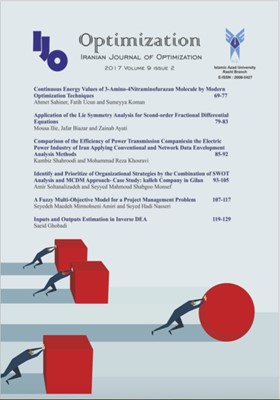-
-
List of Articles
-
Open Access Article
1 - Continuous Energy Values of 3-Amino-4-Nitraminofurazan Molecule by Modern Optimization Techniques
Ahmet Sahiner Fatih Ucun Sumeyya Koman -
Open Access Article
2 - Application of the Lie Symmetry Analysis for second-order fractional differential equations
Mousa Ilie Jafar Biazar Zeinab Ayati -
Open Access Article
3 - Comparison of the Efficiency of Power Transmission Companies in the Electric Power Industry of Iran Applying Conventional and Network Data Envelopment Analysis Methods
Kambiz Shahroodi Mohammad Reza Khosravi -
Open Access Article
4 - Identify and Prioritize of Organizational Strategies by the Combination of SWOT Analysis and MCDM Approach- Case Study: kalleh Company in Gilan
Amir Soltanalizadeh Seyyed Mahmoud Shabgoo Monsef -
Open Access Article
5 - A fuzzy multi-objective model for a project management problem
Seyedeh Maedeh Mirmohseni Amiri Seyed Hadi Nasseri -
Open Access Article
6 - Inputs and Outputs Estimation in Inverse DEA
Saed Ghobadi
-
The rights to this website are owned by the Raimag Press Management System.
Copyright © 2021-2025







